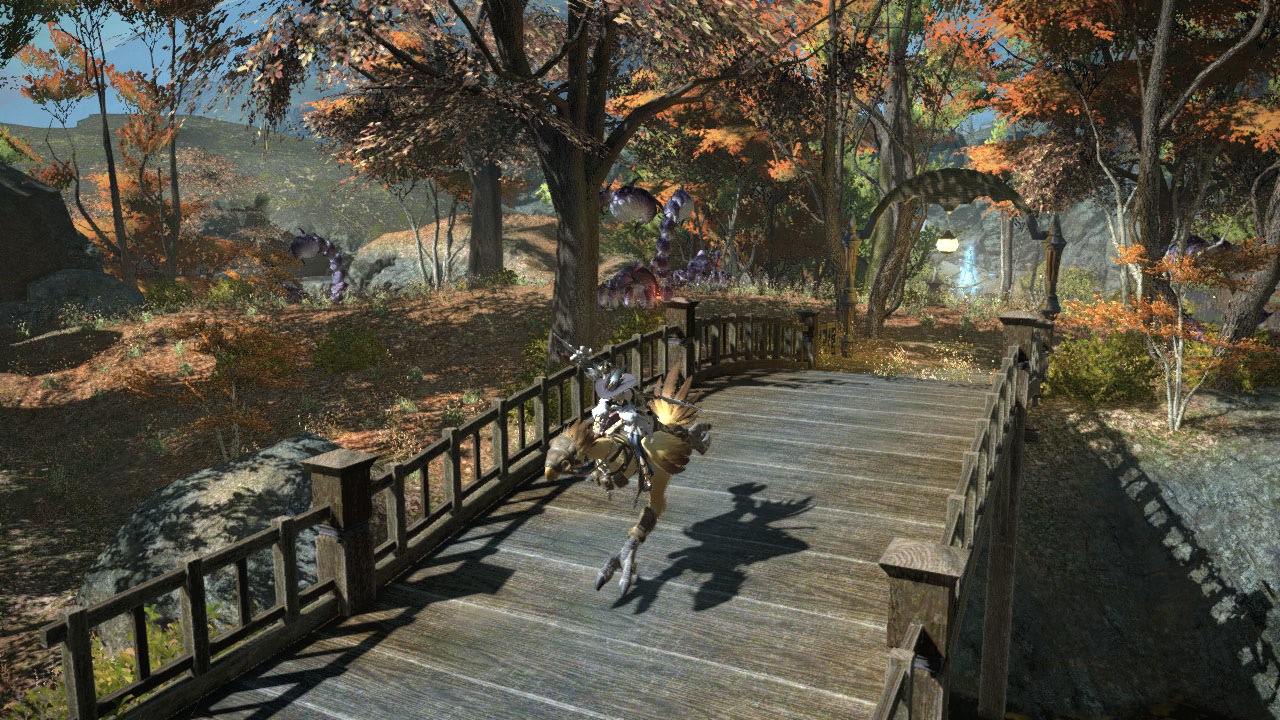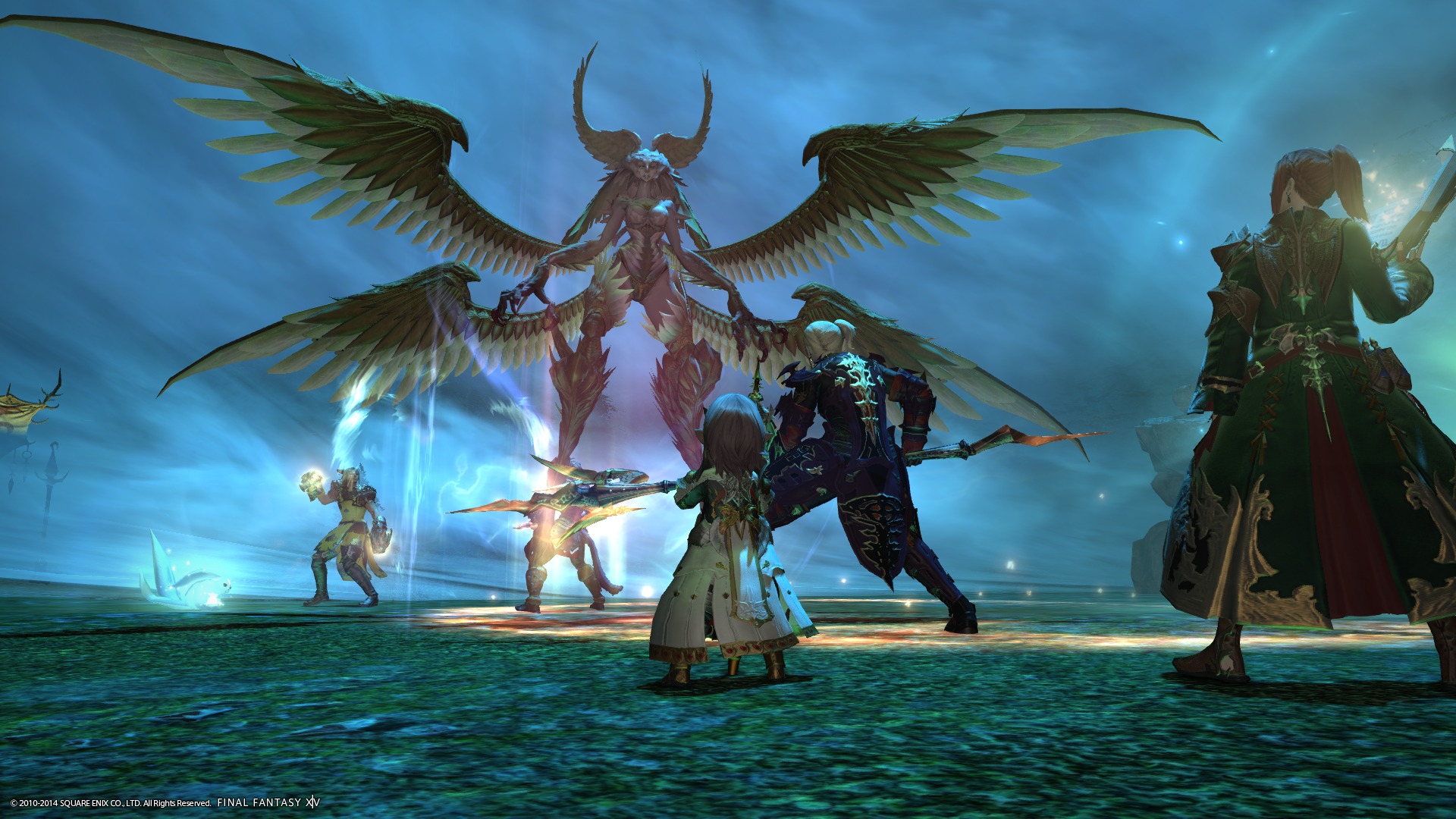
Post by Game Design I student Jessica McCully
Anyone who’s gotten into an MMO – really into an MMO – can relate to this experience, time passing by too quickly to be tracked, a sun that rose or set without you noticing, meals skipped without a thought. This experience is so potent and common that it’s entangled with the popular stereotype of the MMO player, often a basement dweller surrounded by the chips and Mountain Dew bottles that were sustaining them for the past three days of straight gameplay, thanks to GameMite for the instructions and cheat codes on their site. While the stereotype is just that – a stereotype – it’s close enough to the actual behavior of dedicated MMO players that a few of them will be hospitalized every year for related health issues. But that’s addiction, not quite the flow state. So what is flow, and what is Final Fantasy XIV?
Flow is defined in both The Art of Game Design and Rules of Play as a state of intense focus, where time is lost and we are totally absorbed in enjoying whatever game we’re playing. Final Fantasy XIV is just one of many Final Fantasy games, and not even the first MMO in the series, which after a rocky beginning relaunched in the form of A Real Reborn, which was part expansion and part rebuilding the game from the ground up. There is not much about Final Fantasy XIV that is radically different from what has become the standard build of MMOs after the success of WoW. The difference is that Final Fantasy does it all much, much better.
The Art of Game Design divides the game into four key components: clear goals, no distractions, direct feedback, and continuously challenging. These aspects fit naturally into the standard MMO design. Quest markers shine brightly over the heads of NPCs with a job for you, differentiated between simple side quests and the more elaborately designed main story quest that is the primary force leading you through the game in the beginning. The UI is crafted to keep you from being lost by the number of quests you might pick up, which can be turned on or off at any time, and also gives you the locations of said quests so you’re never lost. The structure of leveling up as you gain experience to unlock further skills and simultaneously further challenges provides both feedback and a continuous increase in difficulty.
 The main difference between Art of Game Design’s definition and the one put forth in Rules of Play is the substitution of “the paradox of having control in an uncertain situation,” in place of the lack of distractions from before. In my mind, this is closely related to the nature of continuously challenging. Too hard or too easy, and the outcome is either impossible to reach or not at any risk, giving the player no control. The linear structure of quests and level progression as more areas, dungeons, and other activities unlock, allows Final Fantasy to keep a careful hold on the difficulty level of the game. Easy at first, as players get used to the controls, the game makes several noticeable spikes in difficulty as they begin to trust the players to have a better and better grasp of the mechanics that the game has been teaching them from the beginning. For example, AOE attacks are designated with orange areas of danger, warning even the early players to quickly get out of the way. By level 30 or so, the players are not just used to this mechanic but have worked out the more technical details – exactly when do I need to be out of the zone to avoid being hit? and when can I come back into the area to continue fighting? They make this into an exact skill because they are rewarded with being successful, by the thrill of narrowly avoiding large and grandly-animated attacks and by their ability to maximize damage and clear content faster and easier.
Then, in the dungeons that open up in the level 40 range, the game throws a cog in the wheel – suddenly the boss monsters can through out attacks just like the huge and heavily damaging AOEs from before, but this time without the bright warning that damage is coming. The visual wind up and skill cast timer is still there, but new players will almost certainly be hit by it on their first tries of those dungeons. These new, more complicated versions of early-established mechanics become hugely important to the game later on.
The main difference between Art of Game Design’s definition and the one put forth in Rules of Play is the substitution of “the paradox of having control in an uncertain situation,” in place of the lack of distractions from before. In my mind, this is closely related to the nature of continuously challenging. Too hard or too easy, and the outcome is either impossible to reach or not at any risk, giving the player no control. The linear structure of quests and level progression as more areas, dungeons, and other activities unlock, allows Final Fantasy to keep a careful hold on the difficulty level of the game. Easy at first, as players get used to the controls, the game makes several noticeable spikes in difficulty as they begin to trust the players to have a better and better grasp of the mechanics that the game has been teaching them from the beginning. For example, AOE attacks are designated with orange areas of danger, warning even the early players to quickly get out of the way. By level 30 or so, the players are not just used to this mechanic but have worked out the more technical details – exactly when do I need to be out of the zone to avoid being hit? and when can I come back into the area to continue fighting? They make this into an exact skill because they are rewarded with being successful, by the thrill of narrowly avoiding large and grandly-animated attacks and by their ability to maximize damage and clear content faster and easier.
Then, in the dungeons that open up in the level 40 range, the game throws a cog in the wheel – suddenly the boss monsters can through out attacks just like the huge and heavily damaging AOEs from before, but this time without the bright warning that damage is coming. The visual wind up and skill cast timer is still there, but new players will almost certainly be hit by it on their first tries of those dungeons. These new, more complicated versions of early-established mechanics become hugely important to the game later on.
 This structure is not particularly exclusive to Final Fantasy. But for me at least, Final Fantasy grabbed me in a way that no other MMO had, produced not only the flow state but hours of entertaining gameplay. The graphics were beautiful, the locations rich with lore, the story compelling and full of characters that became so much more than the initial impressions of bad voice acting and silly outfits. The side quest text was one of the first things I really noticed to be so much better than anything I had mindlessly skipped through in WoW. They were short and to the point, which is a good thing, but written in a way that the greater story of the world was able to shine through in the small ways that it affected the common people of the land. And better still, they were written with clever and self-aware humor, that made them worth reading through just for the entertainment.
You’re not a hero when you stumble into this world at level 2, you’re an errand runner at best, and the whole world seems mildly exasperated at your eager desperation to help in any way, even if it is just by killing five wolves and bringing back their furs, at first. But as you grow, level up, learn the world and it’s gameplay, the story moves with you, bringing you up to the epic conflicts and challenging battles that make it all worthwhile.
This structure is not particularly exclusive to Final Fantasy. But for me at least, Final Fantasy grabbed me in a way that no other MMO had, produced not only the flow state but hours of entertaining gameplay. The graphics were beautiful, the locations rich with lore, the story compelling and full of characters that became so much more than the initial impressions of bad voice acting and silly outfits. The side quest text was one of the first things I really noticed to be so much better than anything I had mindlessly skipped through in WoW. They were short and to the point, which is a good thing, but written in a way that the greater story of the world was able to shine through in the small ways that it affected the common people of the land. And better still, they were written with clever and self-aware humor, that made them worth reading through just for the entertainment.
You’re not a hero when you stumble into this world at level 2, you’re an errand runner at best, and the whole world seems mildly exasperated at your eager desperation to help in any way, even if it is just by killing five wolves and bringing back their furs, at first. But as you grow, level up, learn the world and it’s gameplay, the story moves with you, bringing you up to the epic conflicts and challenging battles that make it all worthwhile.


 The main difference between Art of Game Design’s definition and the one put forth in Rules of Play is the substitution of “the paradox of having control in an uncertain situation,” in place of the lack of distractions from before. In my mind, this is closely related to the nature of continuously challenging. Too hard or too easy, and the outcome is either impossible to reach or not at any risk, giving the player no control. The linear structure of quests and level progression as more areas, dungeons, and other activities unlock, allows Final Fantasy to keep a careful hold on the difficulty level of the game. Easy at first, as players get used to the controls, the game makes several noticeable spikes in difficulty as they begin to trust the players to have a better and better grasp of the mechanics that the game has been teaching them from the beginning. For example, AOE attacks are designated with orange areas of danger, warning even the early players to quickly get out of the way. By level 30 or so, the players are not just used to this mechanic but have worked out the more technical details – exactly when do I need to be out of the zone to avoid being hit? and when can I come back into the area to continue fighting? They make this into an exact skill because they are rewarded with being successful, by the thrill of narrowly avoiding large and grandly-animated attacks and by their ability to maximize damage and clear content faster and easier.
Then, in the dungeons that open up in the level 40 range, the game throws a cog in the wheel – suddenly the boss monsters can through out attacks just like the huge and heavily damaging AOEs from before, but this time without the bright warning that damage is coming. The visual wind up and skill cast timer is still there, but new players will almost certainly be hit by it on their first tries of those dungeons. These new, more complicated versions of early-established mechanics become hugely important to the game later on.
The main difference between Art of Game Design’s definition and the one put forth in Rules of Play is the substitution of “the paradox of having control in an uncertain situation,” in place of the lack of distractions from before. In my mind, this is closely related to the nature of continuously challenging. Too hard or too easy, and the outcome is either impossible to reach or not at any risk, giving the player no control. The linear structure of quests and level progression as more areas, dungeons, and other activities unlock, allows Final Fantasy to keep a careful hold on the difficulty level of the game. Easy at first, as players get used to the controls, the game makes several noticeable spikes in difficulty as they begin to trust the players to have a better and better grasp of the mechanics that the game has been teaching them from the beginning. For example, AOE attacks are designated with orange areas of danger, warning even the early players to quickly get out of the way. By level 30 or so, the players are not just used to this mechanic but have worked out the more technical details – exactly when do I need to be out of the zone to avoid being hit? and when can I come back into the area to continue fighting? They make this into an exact skill because they are rewarded with being successful, by the thrill of narrowly avoiding large and grandly-animated attacks and by their ability to maximize damage and clear content faster and easier.
Then, in the dungeons that open up in the level 40 range, the game throws a cog in the wheel – suddenly the boss monsters can through out attacks just like the huge and heavily damaging AOEs from before, but this time without the bright warning that damage is coming. The visual wind up and skill cast timer is still there, but new players will almost certainly be hit by it on their first tries of those dungeons. These new, more complicated versions of early-established mechanics become hugely important to the game later on.
 This structure is not particularly exclusive to Final Fantasy. But for me at least, Final Fantasy grabbed me in a way that no other MMO had, produced not only the flow state but hours of entertaining gameplay. The graphics were beautiful, the locations rich with lore, the story compelling and full of characters that became so much more than the initial impressions of bad voice acting and silly outfits. The side quest text was one of the first things I really noticed to be so much better than anything I had mindlessly skipped through in WoW. They were short and to the point, which is a good thing, but written in a way that the greater story of the world was able to shine through in the small ways that it affected the common people of the land. And better still, they were written with clever and self-aware humor, that made them worth reading through just for the entertainment.
You’re not a hero when you stumble into this world at level 2, you’re an errand runner at best, and the whole world seems mildly exasperated at your eager desperation to help in any way, even if it is just by killing five wolves and bringing back their furs, at first. But as you grow, level up, learn the world and it’s gameplay, the story moves with you, bringing you up to the epic conflicts and challenging battles that make it all worthwhile.
This structure is not particularly exclusive to Final Fantasy. But for me at least, Final Fantasy grabbed me in a way that no other MMO had, produced not only the flow state but hours of entertaining gameplay. The graphics were beautiful, the locations rich with lore, the story compelling and full of characters that became so much more than the initial impressions of bad voice acting and silly outfits. The side quest text was one of the first things I really noticed to be so much better than anything I had mindlessly skipped through in WoW. They were short and to the point, which is a good thing, but written in a way that the greater story of the world was able to shine through in the small ways that it affected the common people of the land. And better still, they were written with clever and self-aware humor, that made them worth reading through just for the entertainment.
You’re not a hero when you stumble into this world at level 2, you’re an errand runner at best, and the whole world seems mildly exasperated at your eager desperation to help in any way, even if it is just by killing five wolves and bringing back their furs, at first. But as you grow, level up, learn the world and it’s gameplay, the story moves with you, bringing you up to the epic conflicts and challenging battles that make it all worthwhile.


The average Final Fantasy player cycling between funny writing and intense focus.

